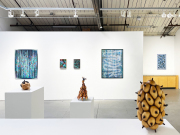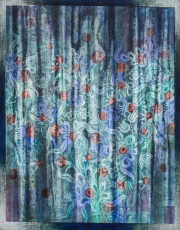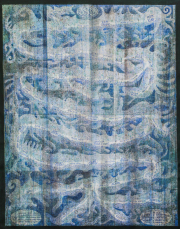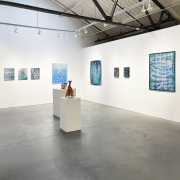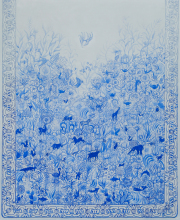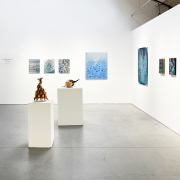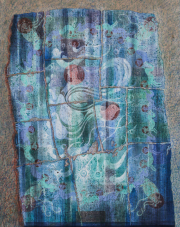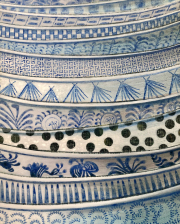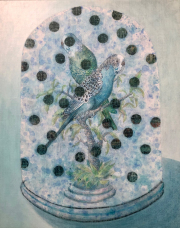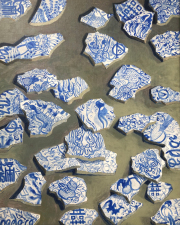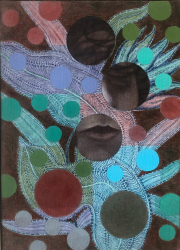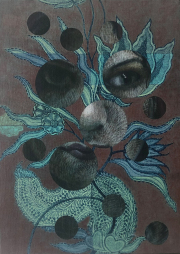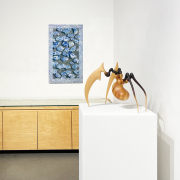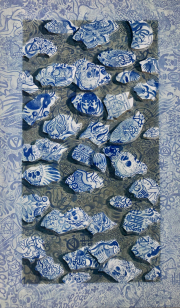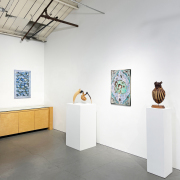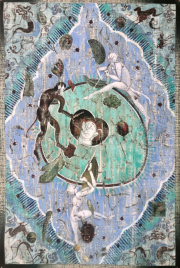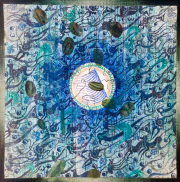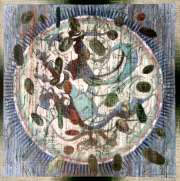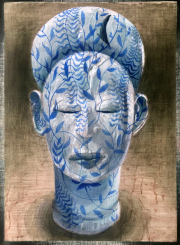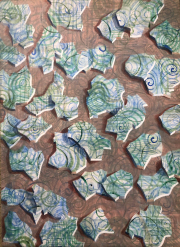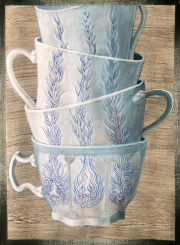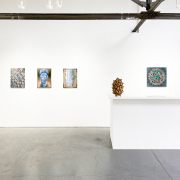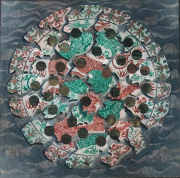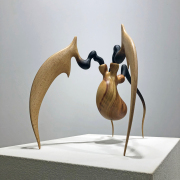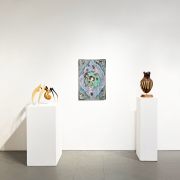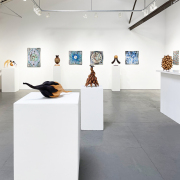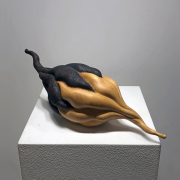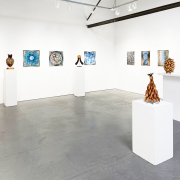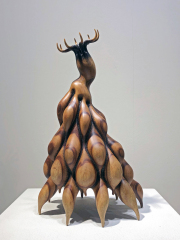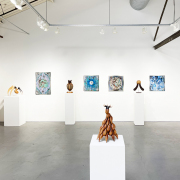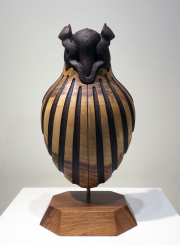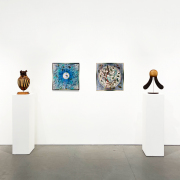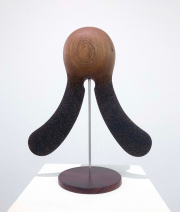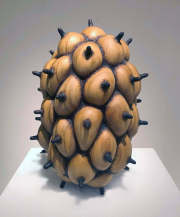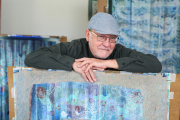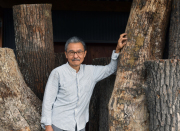.
.
.
Crossroads – Meeting of Minds
Philip Willem Badenhorst
+
Eiichi Tsujino
October 2 to November 16, 2024
NANCY TOOMEY FINE ART
1275 Minnesota Street, San Francisco

Philip Willem Badenhorst, 2 Dragons – Jingdeszhen, 2023, acrylic on Belgian linen canvas, 21 x 21 inches
Nancy Toomey Fine Art is pleased to announce a two-person exhibition of works by Philip Willem Badenhorst and Eiichi Tsujino titled Crossroads – Meeting of Minds on view from October 2 to November 16, 2024. The gallery is located inside San Francisco’s Minnesota Street Project, 1275 Minnesota Street. Gallery hours are Wednesday through Saturday, 12pm to 4pm, and by appointment–please contact nancy@nancytoomeyfineart.com or 415-307-9038.

Philip Willem Badenhorst + Eiichi Tsujino Crossroads – Meeting of Minds exhibition installation view at Nancy Toomey Fine Art, 2024

Eiichi Tsujino, Octabinas, 2024, camphor tree, beech tree, 11 x 9.5 x 18.5 inches
Crossroads – Meeting of Minds is a two-person exhibition at Nancy Toomey Fine Art in San Francisco that brings together Antwerp, Belgium, based painter Philip Willem Badenhorst and Kagawa, Japan, based sculptor Eiichi Tsujino. The two artists met in the early 2000s in Tokyo and, after maintaining a long friendship, last year exhibited their work together in Tsujino’s hometown of Sakaide on the island of Shikoku. In this current show, Philip Willem Badenhorst creates a visually intricate body of paintings that explores the historical and cultural connections between East and West through abstract patterns and symbols. Badenhorst is inspired by literature on the Silk Road and porcelain, while reflecting on themes of memory, spirituality, and the passage of time. Eiichi Tsujino creates realistic sculptures of ancient flora and fauna, using a unique charred wood technique to evoke the textures and warmth of nature while exploring the origins of biodiversity and the interplay of life forms in a quest for beauty and stillness.

Philip Willem Badenhorst, The Road, 2024 (detail view), acrylic on Belgian linen canvas, 45.4 x 35.7 inches
As an avid reader, the main source for Philip Willem Badenhorst’s work has always been tracking and tracing moods and images from a wide range of world literature. For this exhibition Badenhorst delved into Peter Frankopan’s The Silk Roads: A New History of the World, along with Edmund de Waal’s The White Road: Journey into an Obsession on the history of porcelain. Badenhorst’s body of artwork combines the fusion of abstract patterns and fantastical symbols with historical and psycho-geographical connections between East and West, visually exploring the power and beauty of these forgotten histories of social, cultural, and religious exchanges. “The work of Philip Willem Badenhorst is fantastic, both in the literal and the figurative sense of the word; obsessive concentration and delicate refinement,” says world-renowned South African artist and painter Marlene Dumas.

Philip Willem Badenhorst, The Road, 2024, acrylic on Belgian linen canvas, 45.4 x 35.7 inches
Badenhorst’s painting The Road (pictured above) traces the complete Silk Road in the form of a mythical dragon with the Googled distances in kilometers plus the time to walk with a packed camel between stations, from Xi’an to the cities of the Mediterranean. The artist mixes figuration with abstract geometrical forms, with foregrounds and backgrounds that alternate, tempting the viewer to reset focus while being drawn into the filled and busy picture plane. Thin aquarelle-like layers of acrylic paints are built up and sanded down in a repetitive procedure that connects with the Eastern ornamentation of thangka (traditional Tibetan Buddhist paintings) and cosmic maps.

Philip Willem Badenhorst, 33 Shards, 2022, crylic on Belgian linen canvas, 19.11 x 15.12 inches
“I explore the crossroads between the material and the spiritual,” says Badenhorst, “the outer and the inner world. Meditation can be found in the painstaking persistence of detail where one can read ‘the nature of mind’ as well as the passing of time. This distant history of rich cultures with their astonishing inclusivity and religious tolerance fell apart around the time of the Renaissance. The loose shards are not to be puzzled together, even though I tried to connect it all in the picture plane; fore and background, the smallest and the biggest, the map and the territory, shard and soul.”

Eiichi Tsujino, Ramnop, 2015, beech tree, 25 x 8 x 8 inches
Eiichi Tsujino’s artistic themes center on the ancient creatures of flora and fauna, evoking landscapes from a time before humans existed. He imagines the bustling marine life where many species were born and the tranquil beings of tropical rainforests filled with the sounds of nature. In an era where digital technology enables the creation of virtual spaces for convenience and efficiency, Tsujino’s sculptures stand out as tangible objects that embody the warmth and texture of wood, enriched by the fragrance of camphor.

Eiichi Tsujino, Shogun, 2024, camphor tree, muku tree and stainless steel pedestal, 9.5 x 7 x 18.5 inches
For Eiichi Tsujino, creation is an exploration of nature, transforming its vitality and stillness into new forms of life. His unique technique of charring wood enhances his sculptures, developed over years of experimentation with tools like disk grinders and electric heating devices. This method alters the wood’s surface, revealing varied colors and intricate irregularities influenced by the material’s characteristics. Inspired by the evolutionary dance of living organisms, Tsujino draws from the dynamic beauty of forms that facilitate movement, photosynthesis, and self-defense, celebrating their raw and vibrant essence in his work.

Philip Willem Badenhorst, photo by Inga Terblanche
Philip Willem Badenhorst is an Antwerp, Belgium, based artist who was born in 1954 in Colesberg, Big Karoo, South Africa. Badenhorst attended The Michaelis School of Fine Arts at the University of Cape Town where he obtained a BA in Fine Arts in 1976. In 1977 he was granted a Cultural Exchange Bursary from the Flemish Government in Belgium, and in 1980 obtained his MA at the Higher Institute for Fine Arts in Antwerp and was awarded the Prince’s Prize. In 2003 the Flemish Government donated 12 of Badenhorst’s paintings from his series The Narrow Way Within to the Constitutional Court in Johannesburg, South Africa. Badenhorst retired from teaching drawing and painting in 2019 after a 33-year career at three different art academies in Antwerp. He alternately lives in Belgium and South Africa with his wife, the author Marijke Coornaert. Badenhorst’s work has been exhibited nationally and internationally and can be found in various public and private collections.

Eiichi Tsujino, photo by Yuki Tsujino
Eiichi Tsujino is based in Kagawa, Japan, and was born in Sakaide City in 1960. Tsujino earned his degree in sculpture in 1983 from Tokyo University of the Arts, and has had solo exhibitions of his work throughout Asia and Europe. In addition to winning a national drawing contest in Japan in 2014, and exhibiting his work internationally, Tsujino’s sculptures can be found in various private and public collections including the Sakaide Civic Museum and Shionoe Museum of Art, in Kagawa. Crossroads – Meeting of Minds at Nancy Toomey Fine Art in San Francisco is Tsujino’s first exhibition in the United States.
